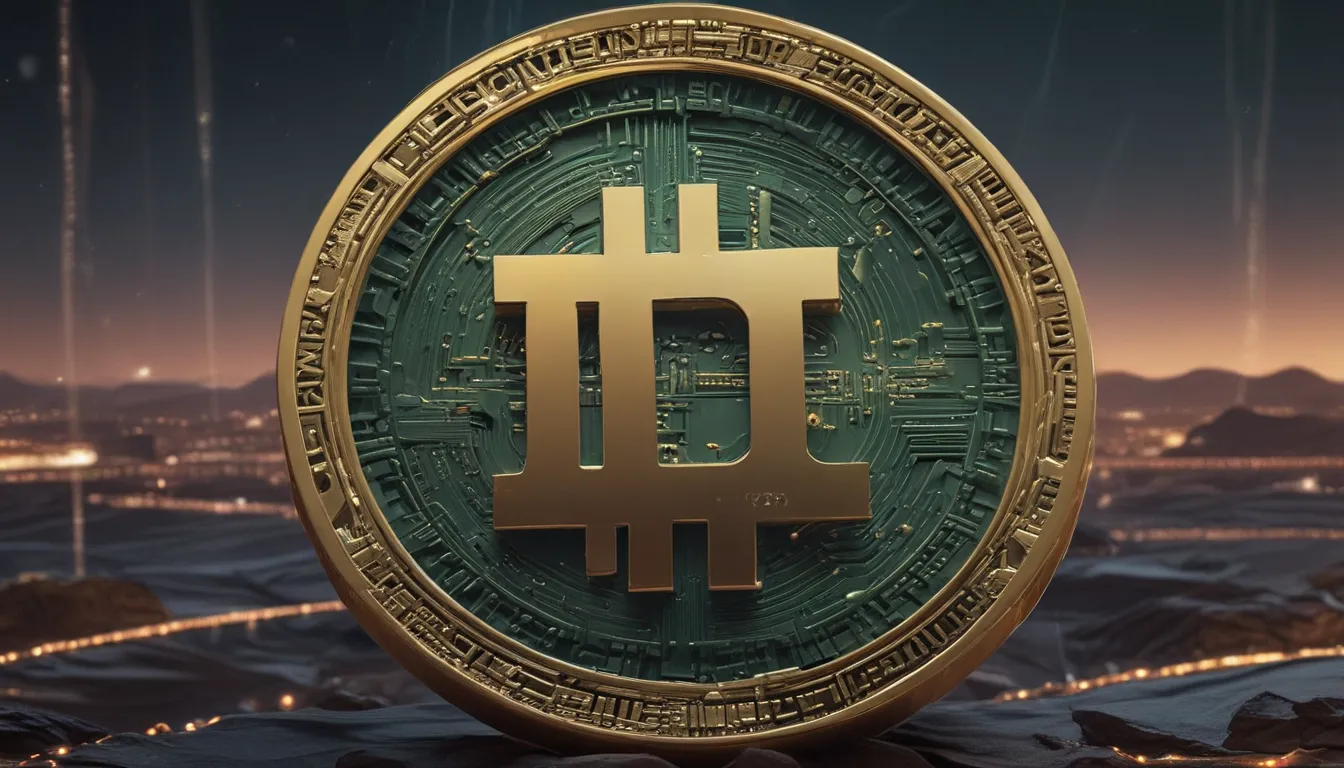A Note About Images: The images used in our articles are for illustration purposes only and may not exactly match the content. They are meant to engage readers, but the text should be relied upon for accurate information.
Cryptocurrency enthusiasts are no strangers to the buzz surrounding Tether (USDT). This stablecoin has carved a niche for itself in the digital currency realm, offering stability and security in a market known for its volatility. If you’re curious about Tether (USDT) and its role in the crypto landscape, you’ve come to the right place. In this article, we’ll unravel 13 intriguing facts about Tether (USDT) that shed light on its unique attributes, uses, and impact on the world of digital currencies. Let’s embark on a journey to discover what makes Tether (USDT) stand out among its peers.
Unveiling Tether (USDT): A Beacon of Stability in the Crypto World
Tether (USDT) is a stablecoin designed to maintain a steady value by pegging it to a reserve of assets, typically the US dollar. This stability makes Tether a popular choice among traders and investors who seek to shield their assets from the unpredictability associated with other cryptocurrencies.
1. Tether: The Trailblazer in Stablecoins
Tether stands tall as the most widely used stablecoin in the crypto market, boasting a market capitalization that ranks consistently high in the cryptocurrency industry. Its widespread adoption positions Tether as the go-to stablecoin for traders and exchanges, solidifying its position as a pivotal player in the crypto ecosystem.
2. A Journey Begins: Tether’s Inception in 2014
The story of Tether dates back to 2014 when it was introduced by Tether Limited. Since its inception, Tether has witnessed exponential growth, with billions of dollars worth of Tether circulating in the market today.
3. Tether’s Multi-Blockchain Endeavors
Initially launched on the Bitcoin blockchain, Tether has expanded its footprint to encompass other blockchain platforms like Ethereum, Tron, and Algorand. This diversification enables users to transact and store Tether across various networks, enhancing its accessibility and flexibility.
4. Ensuring Stability: Tether’s Backing by Reserves
Tether prides itself on maintaining a one-to-one reserve ratio, indicating that for every Tether in circulation, an equivalent amount of fiat currency is securely held in reserves. Despite facing scrutiny and controversy, Tether’s commitment to transparency remains a focal point for ongoing discourse.
5. Tether’s Versatility: Exploring Different Fiat Pegged Versions
While Tether remains primarily pegged to the US dollar, it offers variations tied to other fiat currencies such as the Euro (EURT) and the Chinese Yuan (CNYT). This diverse range of options empowers users to tailor their trading strategies to their specific needs.
Unraveling Tether’s Impact on the Crypto Realm
Tether’s significance transcends mere stability, extending to its role as a facilitator of efficient transactions, a subject of regulatory scrutiny, and a catalyst for the emergence of other stablecoins. Let’s dive deeper into the multifaceted realm of Tether’s influence.
6. Accelerating Transactions: Tether’s Blockchain Advantage
By harnessing blockchain technology, Tether streamlines cross-border transactions, offering swifter and more efficient transfer mechanisms compared to traditional banking systems. This enhanced speed and accessibility position Tether as a favored choice for international remittances and financial transfers.
7. Regulatory Ripples: Tether Navigates the Compliance Landscape
As a prominent stablecoin, Tether has attracted regulatory attention globally, triggering discussions about its transparency, reserve backing, and market manipulation concerns. These regulatory dialogues continue to shape the trajectory of Tether and the broader stablecoin ecosystem.
8. Transparency Triumphs: Tether’s Issuance and Redemption Process
Tether’s commitment to transparency is underscored by its real-time disclosure of token issuance and redemption data on its website. This level of openness aims to instill confidence and trust among users, reinforcing the integrity of the Tether ecosystem.
9. Embracing Versatility: Tether’s Diverse Applications
Beyond its role in trading and investing, Tether finds utility across various sectors, serving as a go-to option for remittances, decentralized finance (DeFi) protocols, and value preservation strategies during crypto market fluctuations.
10. Controversies and Challenges: Tether’s Turbulent Saga
Tether’s journey has been riddled with controversies and legal tussles, ranging from allegations of market manipulation to financial discrepancies. These contentious episodes have influenced public perception and sparked debates about Tether’s stability and reliability.
11. Tether’s Crucial Role: Anchoring the Crypto Market
Amidst the volatility of the crypto landscape, Tether emerges as a beacon of stability and liquidity, bridging the gap between traditional finance and the digital domain. Its pivotal role in facilitating seamless transactions underscores its significance in the cryptocurrency market.
12. A Legacy of Inspiration: Tether’s Influence on Stablecoin Innovation
Tether’s success has not only garnered widespread acclaim but has also catalyzed the creation of numerous stablecoins. These digital currencies aim to emulate Tether’s stabilizing effect while offering users a spectrum of alternative stablecoin solutions to choose from.
Conclusion: Tether’s Evolution and Enduring Impact
Tether (USDT) emerges as a captivating digital currency that has left an indelible mark on the realm of cryptocurrency. From its humble origins to its current stature as a stalwart stablecoin, Tether continues to redefine the dynamics of digital finance. Its pegging to traditional fiat currencies instills confidence and mitigates risks, positioning Tether as a reliable asset in the ever-evolving crypto landscape.
FAQs: Navigating the Realm of Tether (USDT)
Curious minds often seek clarity on common queries surrounding Tether (USDT). Let’s address some frequently asked questions to deepen your understanding of Tether’s utility and nuances.
-
What is Tether (USDT)?
Tether (USDT) is a stablecoin that maintains a stable value by pegging it to traditional fiat currencies like the U.S. dollar. -
How does Tether maintain its peg to the U.S. dollar?
Tether upholds its price stability by backing its circulating tokens with reserves of traditional currency assets, ensuring a one-to-one equivalence. -
Can Tether be used for everyday transactions?
Yes, Tether is suitable for everyday transactions, offering stability compared to volatile cryptocurrencies. -
Is Tether audited for transparency?
Yes, Tether undergoes regular audits to ensure transparency and validate the adequacy of traditional currency reserves. -
Where can one buy and sell Tether?
Tether is available on various cryptocurrency exchanges like Binance, Coinbase, and Kraken for trading purposes. -
Can Tether be converted back into traditional fiat currency?
Yes, Tether can be exchanged for traditional fiat currency through platforms supporting Tether trading pairs. -
Is Tether regulated by governmental authorities?
While not formally regulated by governmental bodies, Tether complies with relevant laws and regulations in its operational jurisdictions. -
What are the advantages of using Tether?
Using Tether offers benefits such as swift transactions, stability, and global acceptance, facilitating seamless fund transfers. -
Are there risks associated with using Tether?
Like any cryptocurrency, Tether entails risks including market volatility and regulatory uncertainties, necessitating informed decision-making. -
Can Tether be used for investment purposes?
While primarily a stablecoin, Tether is used as a store of value by some investors during periods of cryptocurrency price fluctuations. -
Can Tether be utilized for international remittances?
Yes, Tether serves as a viable option for international remittances, offering a cost-effective alternative to traditional money transfer methods. -
What blockchain does Tether operate on?
Tether operates on various blockchain platforms including Ethereum, Tron, and Bitcoin’s Omni Layer each offering unique transaction benefits. -
Can Tether be trusted?
Tether has earned user trust over the years, emphasizing reliability. However, users are advised to conduct diligent research and align decisions with their risk tolerance.
In conclusion, Tether (USDT) exemplifies stability, innovation, and utility in the dynamic realm of digital currencies. Its impact as a cornerstone stablecoin underscores its pivotal role in reshaping financial transactions and bolstering user confidence in the cryptocurrency landscape. As you embark on your crypto journey, Tether stands as a steadfast companion, offering a beacon of stability amidst the turbulent tides of the digital frontier.






